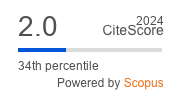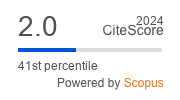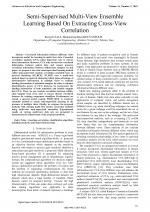| 2/2016 - 15 | View TOC | « Previous Article | Next Article » |
Semi-Supervised Multi-View Ensemble Learning Based On Extracting Cross-View CorrelationZALL, R. |
| Extra paper information in |
| Click to see author's profile in |
| Download PDF |
Author keywords
boosting, correlation, classification algorithm, sampling methods, semi-supervised learning
References keywords
semi(17), supervised(16), learning(15), data(15), recognition(11), multi(10), analysis(10), view(9), pattern(9), training(7)
Blue keywords are present in both the references section and the paper title.
About this article
Date of Publication: 2016-05-31
Volume 16, Issue 2, Year 2016, On page(s): 111 - 124
ISSN: 1582-7445, e-ISSN: 1844-7600
Digital Object Identifier: 10.4316/AECE.2016.02015
Web of Science Accession Number: 000376996100015
SCOPUS ID: 84974853415
Abstract
Correlated information between different views incorporate useful for learning in multi view data. Canonical correlation analysis (CCA) plays important role to extract these information. However, CCA only extracts the correlated information between paired data and cannot preserve correlated information between within-class samples. In this paper, we propose a two-view semi-supervised learning method called semi-supervised random correlation ensemble base on spectral clustering (SS_RCE). SS_RCE uses a multi-view method based on spectral clustering which takes advantage of discriminative information in multiple views to estimate labeling information of unlabeled samples. In order to enhance discriminative power of CCA features, we incorporate the labeling information of both unlabeled and labeled samples into CCA. Then, we use random correlation between within-class samples from cross view to extract diverse correlated features for training component classifiers. Furthermore, we extend a general model namely SSMV_RCE to construct ensemble method to tackle semi-supervised learning in the presence of multiple views. Finally, we compare the proposed methods with existing multi-view feature extraction methods using multi-view semi-supervised ensembles. Experimental results on various multi-view data sets are presented to demonstrate the effectiveness of the proposed methods. |
| References | | | Cited By «-- Click to see who has cited this paper |
| [1] Precup, R. E., David, R. C., Petriu, E. M., Preitl, S., and Radac, M. B. "Fuzzy logic-based adaptive gravitational search algorithm for optimal tuning of fuzzy-controlled servo systems." Control Theory & Applications, Iet 7.1 (2013): 99-107. [CrossRef] [SCOPUS Times Cited 80] [2] El Sehiemy, Ragab, Adel Abou El-Ela, and AbdulAllah Shaheen. "Multi-objective fuzzy-based procedure for enhancing reactive power management." Generation, Transmission & Distribution, IET 7.12 (2013): 1453-1460. [CrossRef] [SCOPUS Times Cited 38] [3] Kazakov, Alexander L., and Anna A. Lempert. "On Mathematical Models for Optimization Problem of Logistics Infrastructure." International Journal of Artificial Intelligence 13.1 (2015): 200-210. [4] Danubianu, M., and St Gh Pentiuc. "Data Dimensionality Reduction Framework for Data Mining." Elektronika ir Elektrotechnika 19.4 (2013): 87-90. [CrossRef] [SCOPUS Times Cited 1] [5] Gacto, María Jose, Gacto, M. J., Galende, M., Alcalá, R., and Herrera, F.. "Metsk-hd e: A multi objective evolutionary algorithm to learn accurate tsk-fuzzy systems in high-dimensional and large-scale regression problems." Information Sciences 276 (2014): 63-79. [CrossRef] [SCOPUS Times Cited 67] [6] X. Shen , Q. Sun, "A novel semi-supervised canonical correlation analysis and extensions for multi-view dimensionality reduction" Journal of Visual Communication and Image Representation, vol. 25, no. 8, pp. 1894-1904, 2014. [CrossRef] [SCOPUS Times Cited 39] [7] A. Blum, T. Mitchell, "Combining labeled and unlabeled data with co-training," Proceedings of the 11th annual conference on computational learning theory, p. 92-100, 1998. [CrossRef] [SCOPUS Times Cited 4702] [8] N. Kamal , R. Ghani, "Analyzing the effectiveness and applicability of co-training" Proceedings of the 9th international conference on information and knowledge management, p. 86-93, 2000. [CrossRef] [SCOPUS Times Cited 882] [9] J. Zhang, D. Zhang, "A novel ensemble construction method for multi-view data using random cross-view correlation between within-class examples," Pattern Recognition, vol. 44, no. 6, pp. 1162-1171, 2011. [CrossRef] [SCOPUS Times Cited 31] [10] H. Hotelling, "Relations between two sets of variates," Biometrika, vol. 28, p. 321-377, 1936. [11] T. Sun, S. Chen, J. Yang, P. Shi, "A novel method of combined feature extraction for recognition," in: Eighth IEEE International Conference on Data Mining, ICDM'08 IEEE, p. 1043-1048, 2008. [CrossRef] [SCOPUS Times Cited 170] [12] Q. S. Sun, Z. D. Liu, P. A. Heng, D. S. Xia, " A theorem on the generalized canonical projective vectors," Pattern Recognition, vol. 38 , p. 449-452, 2005. [CrossRef] [SCOPUS Times Cited 80] [13] Y. Peng, D. Zhang, J. Zhang, "A new canonical correlation analysis algorithm with local discrimination," Neural Processing Letter, vol. 31, 2010. [CrossRef] [SCOPUS Times Cited 78] [14] N. Guan, X. Zhang, Z. Luo, L. Lan, "Sparse representation based discriminative canonical correlation analysis for face recognition," in: 2012 IEEE 11th International Conference on Machine Learning and Applications (ICMLA), p. 51-56, 2012. [CrossRef] [SCOPUS Times Cited 20] [15] X. Chen, S. Chen, H. Xue, X. Zhoun, "A unified dimensionality reduction framework for semi-paired and semi-supervised multi-view data" Pattern Recognition, vol. 45, 2012. [CrossRef] [SCOPUS Times Cited 74] [16] Y. Peng, D. Zhang, "Semi-supervised canonical correlation analysis algorithm" J.Sorftw, vol. 19, 2008. [CrossRef] [SCOPUS Times Cited 33] [17] Z.-H. Zhou, "When semi-supervised learning meets ensemble learning" Frontiers of Electrical and Electronic Engineering in China , vol. 6, no. 1, pp. 6-16, 2011. [CrossRef] [SCOPUS Times Cited 72] [18] L. Breiman, "Bagging predictors" Mach Learn, vol. 24, p. 123-140, 1996. [CrossRef] [SCOPUS Times Cited 19409] [19] Y. Freund, R. Schapire, "Experiments with a new boosting algorithm" In Proceedings of thirteenth international conference on machine learning, p. 148-156, 1996. [CrossRef] [20] S. Sun, Q. Zhang, "Multiple-view multiple-learner semi-supervised learning" Neural processing letters, vol. 34, no. 3, pp. 229-240., 2011. [CrossRef] [SCOPUS Times Cited 53] [21] Emtiyaz, Siavash, and MohammadReza Keyvanpour. "Customers behavior modeling by semi-supervised learning in customer relationship management." Advances in information Sciences and Service Sciences(AISS) 3.9 (2012). [CrossRef] [SCOPUS Times Cited 18] [22] Hassanzadeh, Hamed, and Mohammadreza Keyvanpour. "A two-phase hybrid of semi-supervised and active learning approach for sequence labeling." Intelligent Data Analysis 17.2 (2013): 251-270. [CrossRef] [SCOPUS Times Cited 11] [23] Kholghi, Mahnoosh, and MohammadReza Keyvanpour. "Active Learning Framework Combining Semi-Supervised Approach for Data Stream Mining." Intelligent Computing and Information Science. Springer Berlin Heidelberg, 2011. 238-243. [CrossRef] [SCOPUS Times Cited 3] [24] Kuncheva, Ludmila I., and Juan J. Rodríguez. "A weighted voting framework for classifiers ensembles." Knowledge and Information Systems 38.2 (2014): 259-275. [CrossRef] [SCOPUS Times Cited 215] [25] Imani, Maryam Bahojb, Mohamad Reza Keyvanpour, and Reza Azmi. "Semi-supervised Persian font recognition." Procedia Computer Science 3 (2011): 336-342. [CrossRef] [SCOPUS Times Cited 13] [26] Keyvanpour, Mohammad Reza, and Maryam Bahojb Imani. "Semi-supervised text categorization: Exploiting unlabeled data using ensemble learning algorithms." Intelligent Data Analysis 17.3 (2013): 367-385. [CrossRef] [SCOPUS Times Cited 28] [27] M. Li , Z. Zhou, " Improve computer-aided diagnosis with machine learning techniques using undiagnosed samples" IEEE Transactions on Systems, Man and Cybernetics, vol. 37, no. 6, p. 1088-1098, 2007. [CrossRef] [SCOPUS Times Cited 353] [28] L. Didaci, F. Roli, "Using co-training and self-training in semi supervised multiple classifier systems" Lecture Notes in Computer Science, vol. 4109, p. 522-530, 2006. [CrossRef] [SCOPUS Times Cited 29] [29] C. Leistner, A. Saffari, J. Santner, H. Bischof, "Semi-supervised random forests" in In Computer Vision 2009 IEEE 12th International Conference on IEEE, 2009. [CrossRef] [SCOPUS Times Cited 120] [30] Y. Yaslan, Z. Cataltepe, "Co-training with relevant random subspaces" Neurocomputing, vol. 73, no. 10, pp. 1652-1661, 2010. [CrossRef] [SCOPUS Times Cited 80] [31] J. Wang, S. Luo, X. Zeng, " A random subspace method for co-training" in: Proceedings of the International Joint Conference on Neural Networks (IJCNN 2008), p. 195-200, 2008 . [CrossRef] [SCOPUS Times Cited 65] [32] G. Yu, G. Zhang, Z. Yu, C. Domeniconi, J. You, G. Han, "Semi-supervised ensemble classification in subspaces" Applied Soft Computing, vol. 12, no. 5, pp. 1511-1522, 2012. [CrossRef] [SCOPUS Times Cited 42] [33] K. P. Bennett, A. Demiriz, R. Maclin, "Exploiting unlabeled data in ensemble methods" in Proceedings of the eighth ACM SIGKDD international conference on Knowledge discovery and data mining. ACM, 2002. [CrossRef] [SCOPUS Times Cited 153] [34] P. K. Mallapragada, R. Jin, A. K. Jain, Y. Liu, "Semiboost: Boosting for semi-supervised learning" Pattern Analysis and Machine Intelligence, IEEE Transactions, vol. 31, no. 11, pp. 2000-2014., 2009. [CrossRef] [SCOPUS Times Cited 310] [35] T. Sun,S. Chen, " Locality preserving CCA with applications to data visualization and pose estimation" Image Vision Computing, vol. 25, pp. 531-543, 2007. [CrossRef] [SCOPUS Times Cited 226] [36] O. Kursun, E. Alpaydin, "Canonical correlation analysis for multi view semi supervised feature extraction" Artificial Intelligence and Soft Computing. Springer Berlin Heidelberg, pp. p. 430-436 2010. [CrossRef] [SCOPUS Times Cited 15] [37] A. Kumar, H. Daume, "A co-training approach for multi view spectral clustering" Proceedings of the 28th international conference on machine learning, p. 393-400, 2011. [38] J. Kittler, M. Hatef, R. P. Duin, J. Matas, " On combining classifiers" IEEE Trans Pattern Anal Mach, 1998. . [CrossRef] [SCOPUS Times Cited 4694] [39] Q. Sun, S. Zeng, Y. Liu, P. Heng, D. Xia, "A new method of feature fusion and its application in image recognition" Pattern Recognition, vol. 38, no. 12, p.2437-2448, 2005. [CrossRef] [SCOPUS Times Cited 488] [40] C. Blake, C. Merz, "UCI Repository of Machine Learning Databases," [ [41] P. Belhumeur, J. Hespanha, D.J. Kriegman, " Eigenfaces vs. fisherfaces : recognition using class specific linear projection" IEEE Trans. Pattern Anal., vol. 19, p. 711-720, 1997. [CrossRef] [SCOPUS Times Cited 10352] [42] A. M. Martinez, R. Benavente, "The AR Face Database," CVC Technical Report, vol. 24, 1998. [43] A. Nielsen, "Multi set canonical correlations analysis and multispectral, truly multi temporal remote sensing data," IEEE Trans. Image Process, vol. 11, 2002. [CrossRef] [SCOPUS Times Cited 269] [44] A. Sharma, A. Kumar, H. Daume, D. Jacobs, "Generalized multi view analysis: a discriminative latent space", in: 2012 IEEE Conference on Computer Vision and Pattern Recognition (CVPR), p. 2160-2167, 2012. [CrossRef] [SCOPUS Times Cited 694] [45] C. Hou, C. Zhang, Y. Wu, F. Nie, " Multiple view semi-supervised dimensionality reduction" Pattern Recognition , vol. 43, p. 720-730, 2010. [CrossRef] [SCOPUS Times Cited 109] [46] I. H. Witten and E. Frank, " Data Mining: Practical machine learning tools and techniques" Morgan Kaufmann, 2005. Web of Science® Citations for all references: 0 SCOPUS® Citations for all references: 44,116 TCR Web of Science® Average Citations per reference: 0 SCOPUS® Average Citations per reference: 939 ACR TCR = Total Citations for References / ACR = Average Citations per Reference We introduced in 2010 - for the first time in scientific publishing, the term "References Weight", as a quantitative indication of the quality ... Read more Citations for references updated on 2025-07-02 08:09 in 264 seconds. Note1: Web of Science® is a registered trademark of Clarivate Analytics. Note2: SCOPUS® is a registered trademark of Elsevier B.V. Disclaimer: All queries to the respective databases were made by using the DOI record of every reference (where available). Due to technical problems beyond our control, the information is not always accurate. Please use the CrossRef link to visit the respective publisher site. |
Faculty of Electrical Engineering and Computer Science
Stefan cel Mare University of Suceava, Romania
All rights reserved: Advances in Electrical and Computer Engineering is a registered trademark of the Stefan cel Mare University of Suceava. No part of this publication may be reproduced, stored in a retrieval system, photocopied, recorded or archived, without the written permission from the Editor. When authors submit their papers for publication, they agree that the copyright for their article be transferred to the Faculty of Electrical Engineering and Computer Science, Stefan cel Mare University of Suceava, Romania, if and only if the articles are accepted for publication. The copyright covers the exclusive rights to reproduce and distribute the article, including reprints and translations.
Permission for other use: The copyright owner's consent does not extend to copying for general distribution, for promotion, for creating new works, or for resale. Specific written permission must be obtained from the Editor for such copying. Direct linking to files hosted on this website is strictly prohibited.
Disclaimer: Whilst every effort is made by the publishers and editorial board to see that no inaccurate or misleading data, opinions or statements appear in this journal, they wish to make it clear that all information and opinions formulated in the articles, as well as linguistic accuracy, are the sole responsibility of the author.



